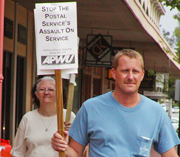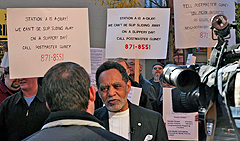Rallying Community Support Is Key to Keeping Post Offices Open
(This article first appeared in the January/February 2010 issue of The American Postal Worker magazine.)
Too far for walking, too crowded for waiting, and too congested for driving and parking.”

The phrase has become almost a mantra in communities where the Postal Service is rushing to shut down retail units, and shunt consumers off to what might be described as “the next nearest Post Office.”
In May, the USPS announced that more than 3,200 stations and branches in Level 24-and-above post offices were being evaluated for possible consolidation or closure. Since then, the number provided to the Postal Regulatory Commission (PRC), congressional panels and the union, has fluctuated.
The most recent figure, filed with the PRC on Nov. 20, was that 241 stations and branches were under consideration for closure, and the APWU continues to spearhead community opposition to hasty decisions to shutter a retail post office.
Albany In an Uproar
In Albany in early November, the Times-Union reported that “Clapping, cheering and hollering filled the Elks Lodge near the Pine Hills Post Office on a Wednesday afternoon as neighborhood residents cheered their local postman.”
The daily newspaper said that 150 people attended a USPS “information session” on the possible closure of two of the New York capital city’s post offices. Members of a neighborhood association distributed copies of a petition with approximately 1,000 signatures, as well as several letters of complaint about the possible station shut-down.
“I think the post office was established as a service,” said Athena Lord, a protesting member of the community. “It was never intended to be a profit-making business.”
According to the paper, “The crowd almost came to a roar when Albany Common Council President Shawn Morris rose to speak. ‘We’ve worked really hard to create a city that’s walkable, enjoyable and sustainable,’ Morris said. ‘It’s really frustrating when another government organization is trying to undo what you’ve done.’”
Serious Accusations in Syracuse
The problems faced by walkers were also a hot-button issue at USPS information sessions in central New York.

According to the Post-Standard, activists in Syracuse compiled more than 2,400 signatures protesting two prospective closures in the city.
Bernie Timmerman, president of the Central New York Area APWU local, explained to the newspaper that it’s important that both offices stay open. The post office in North Syracuse is near two senior citizens facilities, and the next nearest post office is a mile-and-a-half away, Timmerman said.
“It’s like forcing people from going to a store to go directly to a warehouse,” Timmerman said. “The post office is more than a post office to the community it serves. The elderly who don’t drive will have a hard time making the change.”
All Saved in St. Louis
“All St. Louis area post offices have now escaped a nationwide budget-cutting ax,” reported the St. Louis Post- Dispatch on Nov. 12.
After reviewing the data, “they just decided they didn’t want to close them,” a USPS spokesperson said in reference to an announcement that nine stations and branches in the area were being taken off the list of those being considered for closure. A total of 38 St. Louis-area have now been spared since the original lists of possible shut-downs were drawn up.
Fred Wolfmeyer, vice president of APWU’s Gateway District Area Local told the newspaper that community support was responsible for the “change of heart.” As in other parts of the country, union members met with neighborhood groups and members of Congress, and went to offices on their days off to distribute post cards for customers to fill out. Wolfmeyer said that about 3,000 post cards urging that the post offices remain open were passed out in and around St. Louis.
“Our position is that this is a service to the public and we have to keep them open to provide that service,” he said. The APWU local’s president, Anthony Harris, said that many post offices on the original “chopping block” served a population that generally has limited access to transportation.
“It’s one of the stabilizing entities in a community,” Harris said, adding that “Postal Service officials seem to be realizing that.”



